Rocket League Mechanics Ceiling: Master Ceiling Play Techniques
Updated On: November 12, 2025 by Aaron Connolly
Ceiling Mechanics Fundamentals
If you want to get what ceiling mechanics are all about, you need to use the top of the arena as a launchpad for advanced shots and tricky plays. You’ll have to get the hang of some weirdly specific controls and nail your timing to drive up the wall, hop onto the ceiling, and pull off aerial moves that can totally throw off your opponents.
Definition and Importance in Rocket League
Ceiling mechanics fall under advanced techniques where we turn the ceiling into a stage for aerial attacks. We drive up the wall, move across the ceiling, then drop down and strike the ball—all while keeping our flip.
The main benefit? Unpredictability. Most folks expect you to stick to the ground or go for regular aerials. But if you come in from the ceiling, you suddenly have angles defenders just aren’t ready for.
Ceiling shots really shine at Champion rank and above. They aren’t just for scoring, either. We can set up flip resets, mess with opponents’ positioning, or force awkward saves that might give us a rebound.
Heads up: If you haven’t mastered basic aerials and wall play, don’t even bother trying ceiling mechanics yet. They’re tough and you’ll need a solid foundation first.
How Ceiling Shots Work
To start a ceiling shot, you need to set up the ball just right. Pop it off the wall with the right speed and angle. If you mess up here, the whole play falls apart.
After you hit the ball up the wall, follow it by driving up yourself. The tricky bit is sliding from the wall to the ceiling. You have to stay in contact with the ceiling so you keep your flip.
Here’s the usual flow:
- Setup: Drive the ball up the wall at a good speed.
- Follow: Chase the ball up the wall.
- Transition: Slide from the wall onto the ceiling.
- Drop: Let yourself fall off the ceiling while tracking the ball.
- Strike: Use your saved flip to smack the ball hard.
The weird thing is, touching the ceiling doesn’t use up your flip. You can drop down and flip into the ball, even after a few seconds.
Quick tip: Try to have the ball just a bit ahead of you when you start moving onto the ceiling. That sets you up for a solid shot.
Essential Controls and Inputs
Ceiling mechanics demand really tight controls at every step. You’ll need to get comfortable with powerslide, air roll, and boost management if you want to pull these off more than once in a blue moon.
When you’re going up the wall, powerslide lets you tweak your angle without slowing down too much. Get it wrong and you either lose all your speed or can’t line up with the ball.
Air roll is huge during the ceiling transition. Rotate your car smoothly from wall to ceiling. Most folks stick to air roll left or right, since it gives more control than the regular one.
| Control Phase | Key Inputs | Common Mistakes |
|---|---|---|
| Wall Setup | Powerslide + steering | Over-sliding, bad angle |
| Ceiling Transition | Air roll + boost | Rushing rotation |
| Drop and Strike | Air roll + flip | Bad timing, missed flip |
Boost management is just as important. You’ll want enough boost to get up the wall and onto the ceiling, but don’t burn it all—save some for the last second. If you run out halfway, you’re stuck.
Try practicing these moves separately first. Work on just going from wall to ceiling in free play—don’t even bother with the ball at first.
Setting Up Ceiling Shots
Getting the setup right is what makes or breaks a ceiling shot. How you approach the ball, the way you pop it off the wall, and how you manage your boost—all of it matters.
Approaching and Popping the Ball
Your speed as you approach the wall sets up everything. Aim for about 60-70% of supersonic—fast enough to keep momentum, slow enough to adjust.
Stick a little behind the ball as you go up. That way, you have space to hit the pop without overshooting.
The wall pop changes depending on how fast the ball is moving:
- Slow balls: Hit straight through the center for more lift.
- Fast balls: Tap your brakes before hitting so you don’t overdo it.
- Stationary balls: Start farther back on the wall to get a clean hit.
Time your jump right as the ball starts its upward arc from your pop. If you jump too soon, you’ll lag behind. Too late, and you’ll rush it.
Wall Pop Variations
Different situations call for different pops. Brake method works best if the ball’s already moving—just tap the brakes before you hit it to stay in control.
Distance method is for slow setups. Give yourself extra space, then gun it into the ball for a higher, longer pop.
For redirect pops, angle your car so the ball goes toward the goal, not straight up. You’ll need to be spot-on with your timing for this.
Quick tip: Hop into freeplay and practice each pop before trying them in actual games. Start with the ball standing still, then try it while it’s moving.
Boost Management During Setup
You have to conserve boost during setup or you’ll run dry before the shot. Use about 30-40 boost to get up the wall—enough for speed, but don’t waste it.
After you leave the wall, don’t boost right away. Let gravity and your momentum do the work while the ball goes up. That way, you’ll have more boost left for adjustments.
Best boost usage pattern:
- Wall approach: 30-40 boost
- After leaving wall: Coast for half a second or so
- Positioning: Use small boost taps (5-10 boost each)
- Shot: Spend the rest for power
If you can, grab boost pads on the wall as you go up. Those little boosts can be the difference between a weak shot and a banger.
Ceiling Shot Execution Techniques
To really nail ceiling shots, you need three core skills: ceiling positioning, a clean first touch, and keeping control in the air. Each step builds on the last, so you want to get them all down.
Climbing and Disengaging from the Ceiling
Start your ceiling play by driving up the wall at a steady pace. Try to keep your car straight and head toward your target spot.
As you hit the ceiling, use a bit of boost to keep your speed up. Your car should flip upside down as you move from the wall to the ceiling.
Some positioning tips:
- Don’t go too fast—control is more important than speed.
- Stick to the center third of the ceiling if you can.
- Use air roll to tweak your car’s angle.
When it’s time to drop, just stop boosting and let gravity pull you off. Don’t flip or jump off the ceiling, or you’ll lose your saved flip for the shot.
Watch where the ball is and time your drop so you fall a hair behind it. That way, you can catch up and hit it as you both head toward the net.
Initial Touch and Ball Contact
Your first touch after dropping off the ceiling is everything. Come at the ball from a little underneath to get the best launch.
Contact basics:
- Hit the bottom third of the ball.
- Use your car’s nose or corner for more control.
- Keep your speed steady as you approach.
The ball should pop up and forward when you hit it. If it flies sideways or backward, you probably hit it wrong.
Different parts of your car change the shot. Corners add spin and make things unpredictable. The nose gives you a direct, powerful hit.
Try to land the same touch over and over in training. The more consistent your first hit, the better your shots will be.
Consistent Ball Control in Mid-Air
After that first touch, you need to steer the ball toward the net and keep your car under control. That takes careful boost taps and steady steering.
Don’t hold boost down—use small taps to control your speed and path.
Mid-air control tips:
- Make tiny stick adjustments.
- Use air roll to fine-tune your position.
- Stay lined up with the ball’s path.
Watch how the ball spins. If it’s spinning, it might drift a bit, so aim for where it’s really headed.
Save your flip from the ceiling drop for the last second. That extra burst can surprise goalies and add power.
Try to chain together a couple touches in the air. The best ceiling shots sometimes need two or three hits before you go for the goal.
Ceiling Pinch and Other Ceiling-Based Shots
Ceiling-based shots let you use the ceiling’s weird physics and timing to launch attacks that defenders just aren’t ready for. These aren’t easy to pull off, but if you can set them up, you get some seriously strong offensive plays.
How to Perform a Ceiling Pinch
A ceiling pinch happens when you trap the ball between your car and the ceiling. This can fire the ball at wild speeds.
What you need:
- Hit the wall fast.
- Transition smoothly onto the ceiling.
- Keep the ball a little ahead of your car.
Hold your speed as you go from the wall to the ceiling. Try to hit the ball right as it touches the ceiling, with your car making contact from below.
Start out in freeplay with unlimited boost. Drive up the wall, get onto the ceiling, and practice keeping the ball close without touching it too soon.
Common screw-ups:
- Hitting the ball before you’re on the ceiling.
- Going up the wall too slowly.
- Bad car position during the pinch.
Ceiling pinches work best with a long run-up. Custom training packs can make this tough since you have less space.
Most players never see ceiling pinches coming. They’re great for counterattacks or when you need to break through pressure.
Ceiling Double Tap Basics
A ceiling double tap means you hit the ball off the ceiling, then follow up with another aerial touch to score.
Start by aiming the ball toward the ceiling. Your first hit bounces it down. Then, follow up and redirect it into the net.
Steps:
- Line up the ball for a ceiling bounce.
- Hit it toward the ceiling at the right angle.
- Track the ball’s fall.
- Hit it again in the air.
Timing is everything. You have to read the bounce and get in position for the follow-up.
The ceiling bounce messes with defenders. Balls dropping from above are just hard to clear.
Training ideas:
- Try ceiling shot training packs.
- Practice in freeplay with unlimited boost.
- Work on getting your first touch accurate.
Double taps are especially good in 2v2 and 3v3. The odd angle makes them a nightmare to defend.
Creative Uses for Ceiling Mechanics
Ceiling moves aren’t just for shots. You can use them for passes, fakes, and even better positioning.
Ceiling Passes are awesome in team plays. Drop the ball from the ceiling to a teammate near the goal. Defenders hate dealing with balls coming straight down.
Fake Ceiling Shots are when you drive on the ceiling but don’t touch the ball. Defenders react, but you keep possession or set up a pass.
Recovery Moves use the ceiling to get back into play. After a big aerial, land on the ceiling and drive to safety.
Boost Management gets easier with ceiling tricks. You save boost by using the ceiling’s momentum instead of always flying.
| Ceiling Mechanic | Best Game Mode | Difficulty Level |
|---|---|---|
| Ceiling Pinch | 2v2, 3v3 | Intermediate |
| Double Tap | All modes | Advanced |
| Ceiling Pass | 3v3 | Intermediate |
| Recovery | All modes | Beginner |
Try these out in private matches with friends. Take turns going for different ceiling shots. It’s a good way to get practice under pressure—without risking your rank.
Essential Advanced Mechanics for Ceiling Play
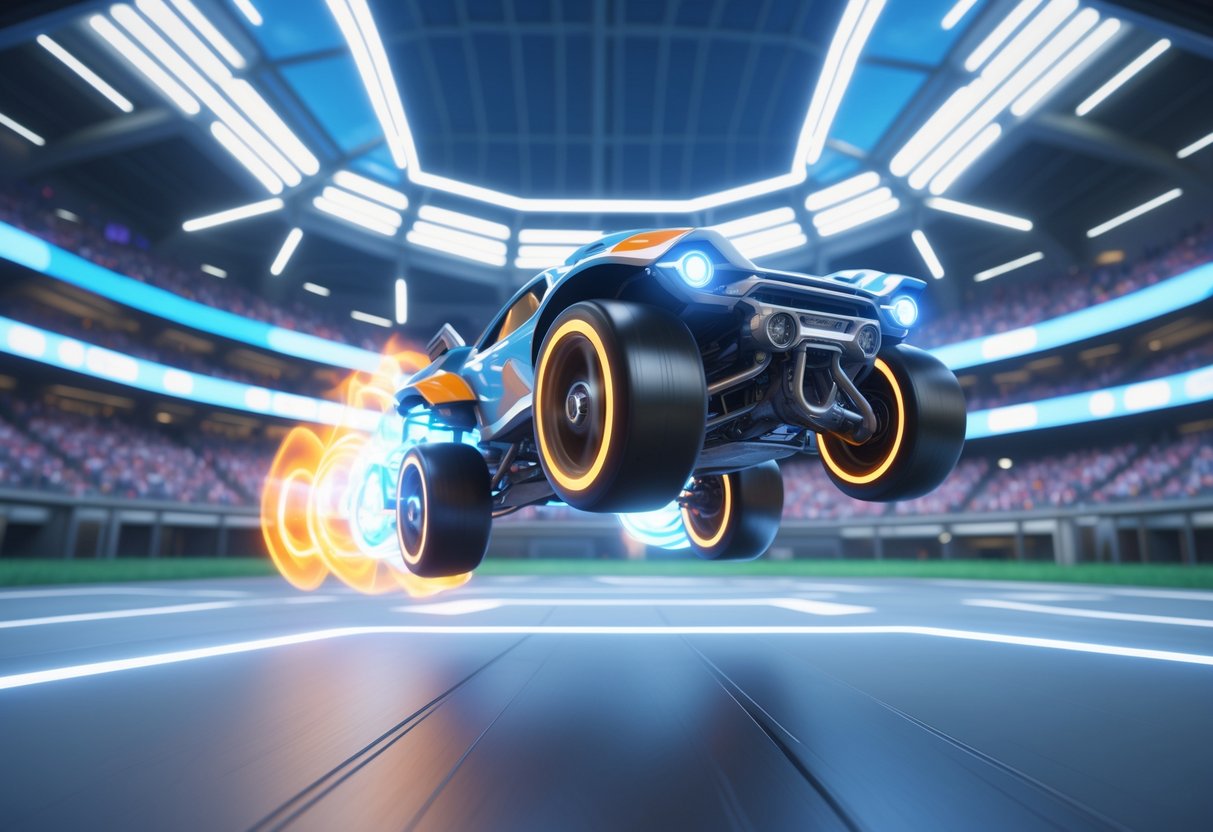
If you want to master ceiling play, you’ll need three core skills: precise air roll control to keep your car oriented, flip reset techniques for unpredictable attacks, and momentum management to stay effective after landing. These advanced mechanics really do separate casual players from those who actually threaten in competitive matches.
Air Roll Control
Directional air roll is the bread and butter for ceiling shots and flip resets. You have to control your car’s rotation while falling off the ceiling to line up shots.
Start by binding air roll left and right to separate buttons. Most folks use L1 and R1 on controller, or Q and E if you’re on keyboard.
Practice with small adjustments first. Hold air roll for quick bursts, not long spins. That way, you won’t over-rotate.
Key tip: Use air roll to tweak your car’s nose angle while you boost forward. This combo lets you aim shots and keep your speed.
A lot of people spin too much or hold air roll down too long. Quick taps usually work better than full spins for most ceiling shots.
Training focus:
- Micro-adjustments while boosting
- Controlling how fast you rotate
- Mixing air roll with boost control
Flip Resets from the Ceiling
You get a flip reset when all four wheels touch the ceiling. That gives you your dodge back—super useful for powerful, unpredictable shots.
Setup: Drive up the wall to the ceiling. Make sure all wheels hit the surface at once for the reset to count.
Timing matters a ton. After you fall from the ceiling, use your regained flip right as you strike the ball.
How to do it:
- Drive straight up the wall to the ceiling
- Let all wheels touch the ceiling
- Fall toward the ball and keep control
- Use your flip close to the ball for max power
Boost management is huge here. Save enough boost for your approach and the shot itself. A lot of players burn through their boost just getting up there.
The best players mix flip resets with air roll control. That lets them hit shots from angles that goalkeepers just can’t predict.
Maintaining Momentum After Landing
Landing well after a ceiling play keeps you active, not stuck recovering. Messy landings just waste the advantage you’ve worked for.
Land on your wheels if you can. This lets you drive right away instead of flipping over or bouncing around.
Use small bursts of boost to control your descent speed. Slower landings are easier to handle, but they give your opponents more time to reset.
Recovery tips:
- Aim your car downward before you land
- Use air roll to get your wheels facing the ground
- Keep a bit of boost for after you land
Wave dashing helps you keep your speed after landing. As soon as you touch down, dodge forward to turn your downward momentum into forward speed.
Positioning awareness is key. After ceiling plays, you’re often out of position. Quick recovery helps you get back into rotation faster.
Practice different landing spots. Corner landings need different techniques than landing mid-field.
Boost Management Above the Field

Managing boost during ceiling plays takes planning, both for getting up there and for making your shot. You’ve got to balance getting to the ceiling quickly with saving enough boost for the actual play.
Boost Pathing to the Ceiling
Planning your route really matters. If you choose the right path, you’ll reach the ceiling with some boost left. Otherwise, you might get up there empty.
The supersonic fast aerial technique is the way to go for ceiling shots. Drive at supersonic speed, jump at the halfway line, and use your double jump with the stick held down.
Small boost pads are a lifesaver. You can pick up 12 boost from each pad on your way up, and it adds up. Try to hit two or three of them as you go.
Boost timing is more important than just having a full tank. You only need about 50 boost to get to the ceiling if you use the fast aerial right. Save the rest for the shot.
Boost Usage During Shot Execution
Preserve boost during setup by using your momentum. Don’t waste boost on little corrections once you’re close to the ceiling.
Timing your boost during the shot gives you more power and accuracy. Use short bursts, not a long hold. That gives you more control.
If you’re low on boost when you reach the ceiling, keep it simple—maybe just drop the ball or pass instead of going for a wild shot.
Think about your recovery before you even take the shot. Make sure you have enough boost left to land safely and rotate back.
Ball Prediction and Reading
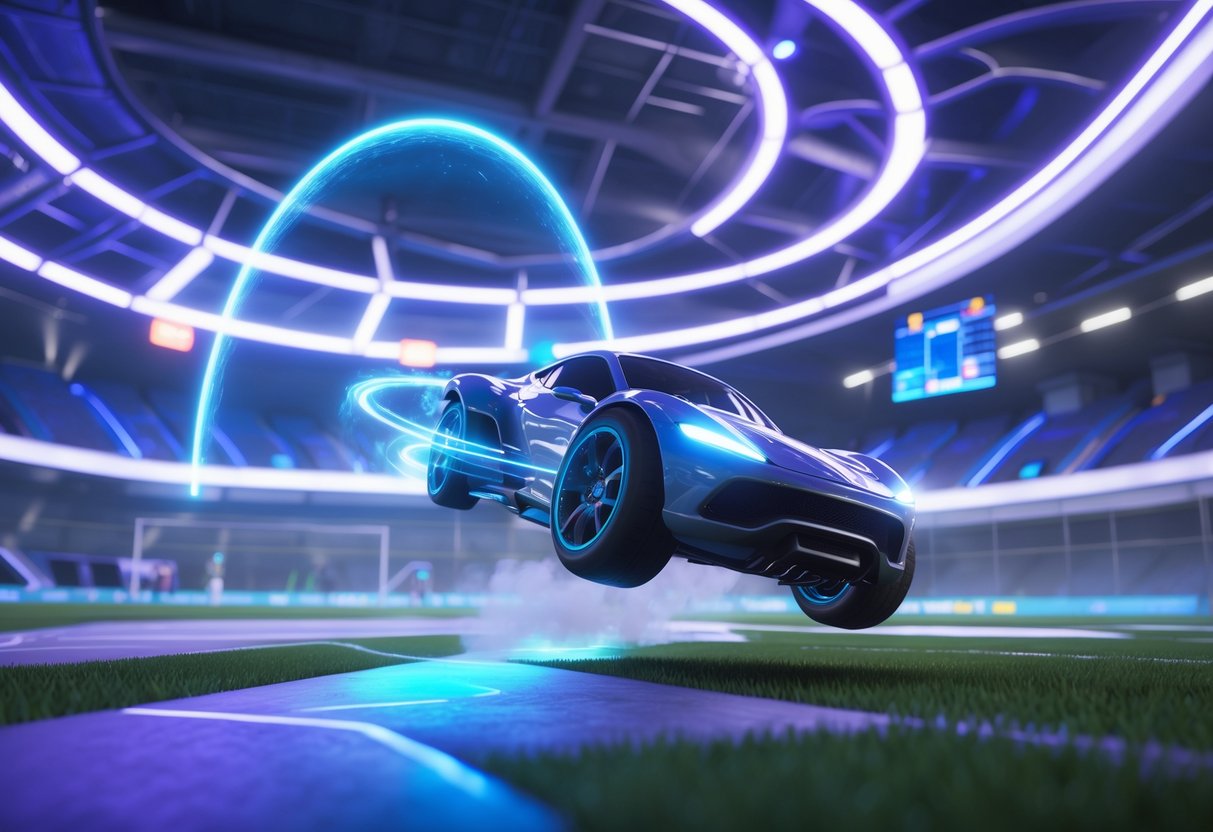
Reading the ball’s path from above gives you a real edge with ceiling shots. If you can figure out how opponents might mess with your plan, you’ll adapt faster and stay ahead.
Reading Ball Trajectory from the Ceiling
When you’re on the ceiling, the ball just looks different. You have to track where it’s going, not just where it is.
Watch for:
- The ball’s speed and direction
- How it bounces off walls
- Any changes in height
The ball usually moves in predictable arcs. From up top, you’ll see these paths more clearly than players on the ground. That gives you extra time to set up your shot.
Distance is everything. If the ball’s too far, you’ll miss your timing. Too close, and you won’t have room to get up to speed.
Try watching the ball while you’re upside down in free play. Your brain needs time to get used to this angle. Just hang from the ceiling and follow the ball with your camera for a while.
Boost amount changes everything. Low boost means you’ll need the ball closer. High boost lets you chase balls further from your ceiling spot.
Adjusting to Opponent Interference
Opponents will try to hit the ball away or challenge you in the air. You need backup plans before you drop from the ceiling.
Common moves:
- Hitting the ball up to clear it
- Challenging you mid-air
- Sitting below to block your shot
Quick adjustments:
- Wait half a second before dropping
- Aim for a pass instead of a shot
- Fake the ceiling shot and rotate out
If an opponent gets the touch first, don’t freak out. Sometimes their hit actually sets up a better ceiling shot for you. Just watch where the ball goes and react.
If you notice an opponent is low on boost, they probably can’t challenge you up high. But if they’ve got plenty, they might beat you to the ball.
Always have an escape route in mind. If the ceiling shot isn’t there, rotate out and look for your next play.
Training Strategies for Mastery

Honestly, the best way to master ceiling mechanics is to grind free play sessions and specific training packs. These routines build muscle memory and help you nail the timing for ceiling shots.
Free Play Drills
Free play is perfect for practicing ceiling mechanics. Drive up the walls and hit the ball toward the ceiling over and over. You’ll build up basic car control that way.
Try to keep your boost up while you’re upside down. It’s surprisingly tricky to manage boost when you’re inverted.
Mix up your approaches. Sometimes roll off the ceiling slowly, other times use a fast aerial. Each approach sets up different shots.
Try these:
- Wall-to-ceiling transitions (10 minutes a day)
- Boost management upside down (5 minutes)
- Ball control from the ceiling (15 minutes)
Set a small goal for each session. Maybe hit three ceiling touches in a row, or stay on the ceiling for five seconds. It keeps you focused.
Use air roll to tweak your orientation while you’re up there. Try both left and right air roll to see what feels best.
Custom Training Packs for Ceiling Shots
Custom training packs give you consistent setups for ceiling shots. These packs throw you into real game scenarios where ceiling mechanics shine.
Some packs focus on power, others on accuracy. Download a few to cover all the bases.
Look for packs like:
- Basic ceiling shots for starters
- Advanced flip resets from the ceiling
- Defensive ceiling clears
- Ceiling-to-goal redirects
Run each shot 10-15 times before moving on. Consistency is more important than nailing one crazy shot. Focus on hitting the ball cleanly first, then add power.
If you mess up the setup, just reset. Good practice means starting from the same spot each time.
Track your progress each week. Try to hit 60% accuracy on basic ceiling shots before moving up to flip resets or weird angles.
Rank Progression and Ceiling Mechanics

Learning ceiling mechanics really does follow your rank progression in Rocket League. Most players should focus on basic aerials before trying advanced ceiling shots in real matches.
Mechanics by Rank
It makes sense to work on certain ceiling skills at each rank. Bronze to Gold players should stick with basic aerials and wall play before even thinking about ceiling mechanics.
If you’re in Platinum or Diamond, start learning simple ceiling drops. That means driving up the wall to the ceiling and dropping down for basic shots. It’s a solid foundation for the fancier stuff.
Champion players usually start practicing real ceiling shots. At this level, you’ll have enough control to pull off shots after falling from the ceiling. Focus on timing your flip after the four-second reset.
Grand Champion and SSL players go for the wild stuff: ceiling pinches, musty flicks, flip resets, and passing plays. The mechanical jump here is no joke.
| Rank | Ceiling Mechanic Focus |
|---|---|
| Bronze-Gold | Wall play basics |
| Platinum-Diamond | Ceiling drops |
| Champion | Basic ceiling shots |
| Grand Champion+ | Advanced ceiling techniques |
Integrating Ceiling Shots into Competitive Play
Ceiling shots work best as surprise attacks, not forced plays. Natural opportunities pop up when the ball bounces high off the back wall or during a counter when opponents are out of position.
In 2v2 and 3v3, ceiling shots put a ton of pressure on defenders. Your teammates can follow up on rebounds, and opponents often can’t defend the angle.
Timing beats frequency every time. One well-timed ceiling shot per match can be way more effective than spamming them. Most opponents won’t see it coming, so you get a tactical advantage.
Heads up: Don’t telegraph your ceiling shot. Going up the wall slowly tells experienced players exactly what you’re doing.
Practice ceiling shots in private matches with limited boost before taking them into ranked. It makes your muscle memory more realistic.
Common Mistakes and Troubleshooting

Most ceiling shot fails happen because you lose control after dropping from the ceiling or run out of boost at the worst moment. Usually, it’s all about poor timing or burning boost too fast during setup.
Losing Control After Ceiling Disengage
The second you drop from the ceiling, gravity takes over. A lot of players panic and spam air roll, which just wastes time and boost.
Stay upside down instead of rolling constantly. It feels weird at first, but it’s key for good ceiling shots.
Don’t try to fly back up—just let yourself fall. You’re falling with style, not actually flying. Gravity’s going to win either way.
Boost down and forward so gravity helps you reach the underside of the ball for that last touch.
If the ball bounces off the ceiling, jump down right away. You’ve got about 1.5 seconds to make contact before you lose your flip.
Practice upside-down control in free play. Start simple before you try full ceiling shots.
Poor Boost Management Solutions
Boost starvation ruins more ceiling shots than bad technique ever will. You need every bit of boost to pull these shots off right.
Start near boost pads when you can. The corner pads and midfield spots usually set up ceiling shots best.
Try to hit the ball harder during setup. A strong first touch lets the ball float longer, so you get a few extra seconds to catch up, even if you’re low on boost.
Don’t waste boost on air rolling. Every little air roll eats up boost you’ll want for your final approach and the actual shot.
Think of boost usage in three parts:
- Setup and wall climb (use a moderate amount)
- Ceiling drive and drop (use as little as possible)
- Final approach and shot (spend whatever you have left)
Use wall dashing to close big gaps fast. Double-tap jump as you drive up the curve of the wall and you’ll get a burst of speed without burning boost.
If boost runs low, focus on positioning instead of power. Sometimes a weak but well-placed shot wins out over a wild, powerful miss.
Advanced Tips from Pro Players
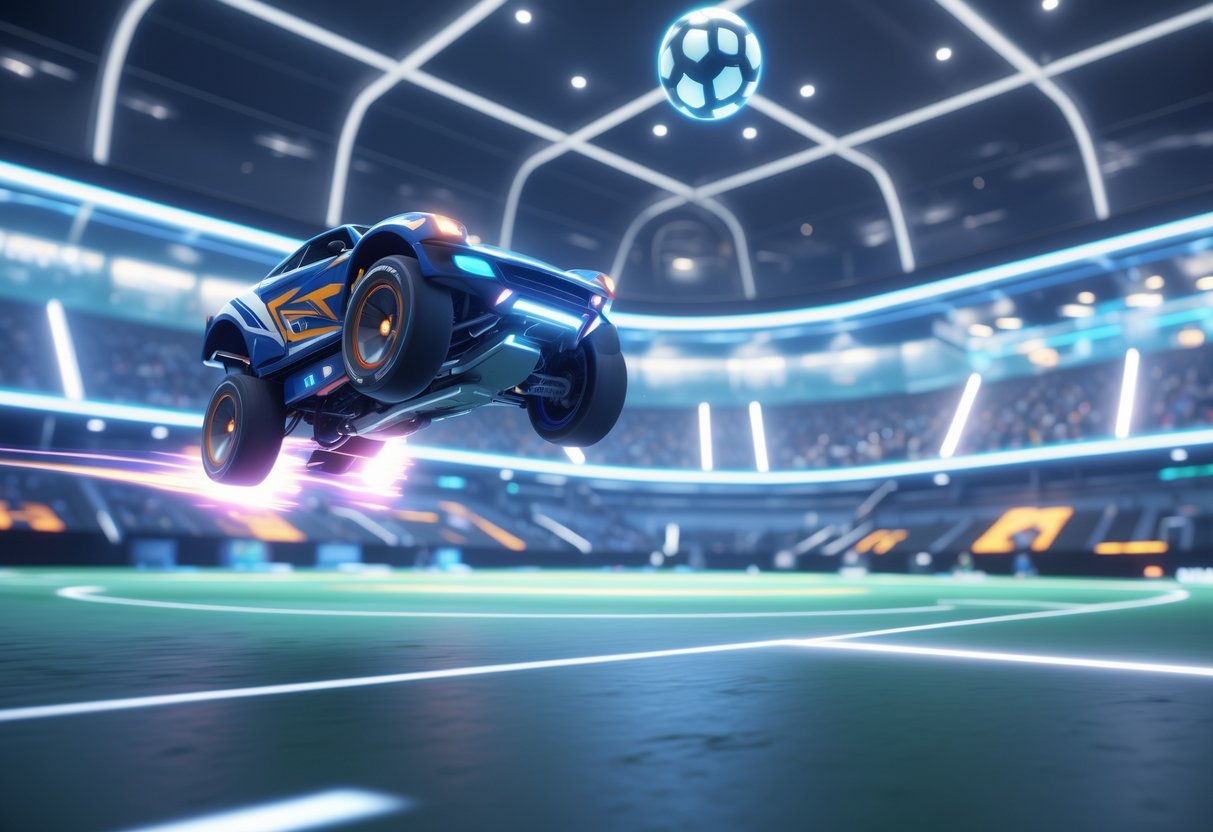
Pro players rely on two main skills for consistent ceiling shots: sharp timing based on what’s happening in the game, and smart positioning for the best scoring chances.
Situational Awareness
Always read the game before going for a ceiling play. Pros check their boost, where the opponents are, and what their teammates are doing before they commit.
Check these factors first:
- Your boost meter (you want at least 50)
- Where the opponent’s goalie is and how much boost they have
- If a teammate can follow up
- The ball’s path and speed
The best ceiling shots come when defenders are out of position or running low on boost. Don’t bother with ceiling plays if the defense is stacked and full on boost.
Quick tip: Count to two after the ball hits the ceiling before you drop. It helps you time your shot and control the angle better.
Pros also look for fake opportunities. Sometimes just starting a ceiling play makes defenders panic and rotate awkwardly, even if you don’t finish the shot.
Optimising Positioning for Ceiling Plays
Proper wall and ceiling positioning creates scoring chances. Pros care more about their approach angle and speed than about flashy mechanics.
Wall approach technique:
- Go up the wall at a 45-degree angle
- Match the ball’s speed, don’t rush it
- Hit the ball with your car’s corner for a better pop
The ceiling spot you drop from matters most for accuracy. Aim to drop when the ball is about a car length from the goal.
Heads up: Lots of players drop too early. Be patient and hold out for the right moment.
Speed control really separates good ceiling shots from great ones. Feather your boost on the ceiling to keep the right distance from the ball. If you go too fast, the shot gets predictable.
Turn your car perpendicular to the goal as you drop. This gives you more shooting angles and makes it tougher for the keeper to guess your shot.
Expanding Beyond Ceiling Shots
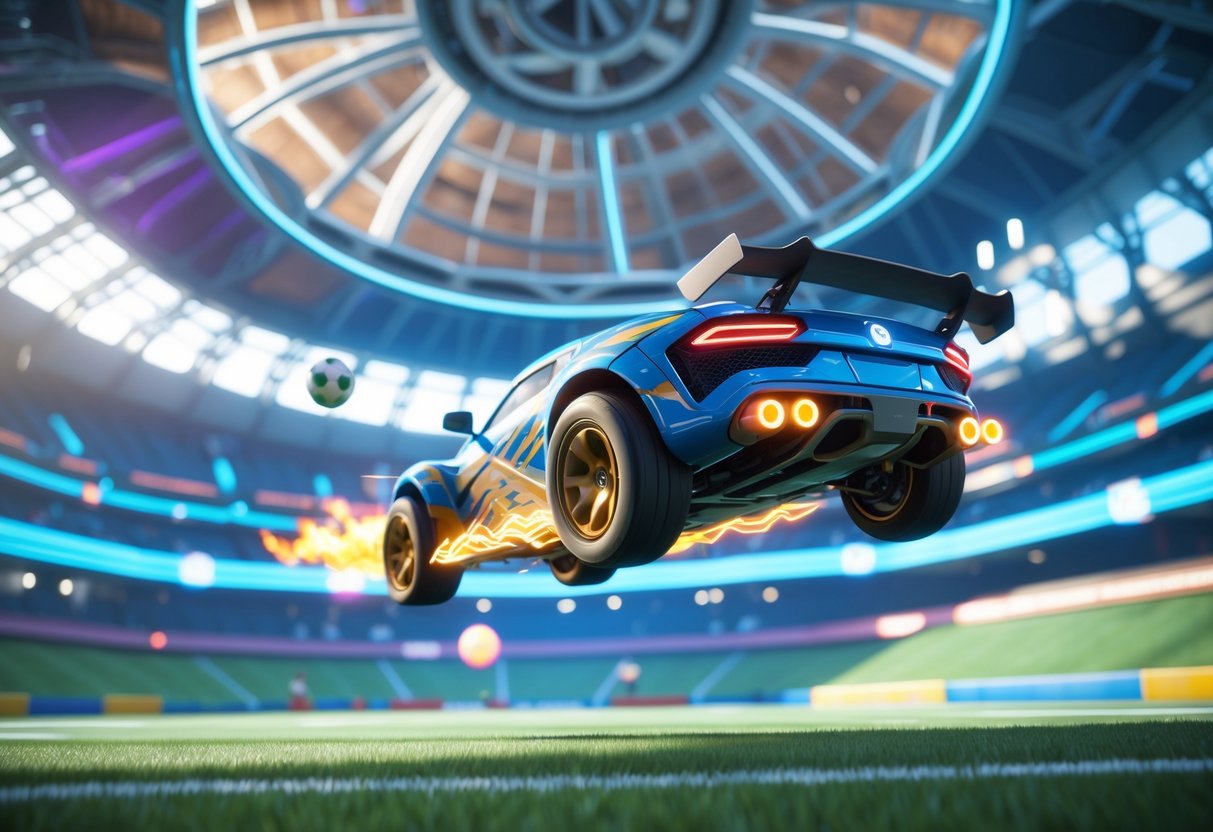
If you master ceiling shots, you open up a bunch of advanced mechanics that can really change your game at higher ranks. These skills work together to make your attacks and defense less predictable.
Transferring Ceiling Mechanics to Other Advanced Plays
The control you build from ceiling shots directly helps with flip resets and double touches. When you practice getting off the ceiling smoothly, you’re learning the same boost management you’ll use for flip resets.
Air dribbles get a lot easier once you understand ceiling positioning. You start to notice how the ball reacts when you come at it from different spots.
Wall-to-air dribbles use timing that’s a lot like ceiling shots. The main difference is you start from the wall, not the ceiling.
Try these practice steps:
- Begin with basic ceiling touches before you try flip resets
- Practice air dribbles from both the wall and the ceiling
- Focus on car control during long aerial plays
Many players say ceiling shot practice helps their defensive aerials too. The spatial awareness you pick up makes awkward saves and clears less scary.
Developing Creativity with Aerial Techniques
Advanced mechanics really shine when you mix them up creatively. Instead of just doing ceiling shots, try setting up your teammates or going for passing plays.
Ceiling shots can turn into redirects if your teammates are in the right spot. That can catch defenders way off guard—way more than a solo ceiling shot.
Double tap setups often start with ceiling positioning. You can use the ceiling to create weird ball bounces that defenders don’t expect.
Think about these creative ideas:
- Fake ceiling shots to pull defenders out of place
- Use the ceiling for shadow defense
- Combine ceiling shots with routes that steal boost
The best players don’t stick to just one advanced move. They mix ceiling shots with ground plays, making their attacks unpredictable and tricky to read.
Practice blending ceiling plays with simple shots like power shots or placement shots.
Frequently Asked Questions
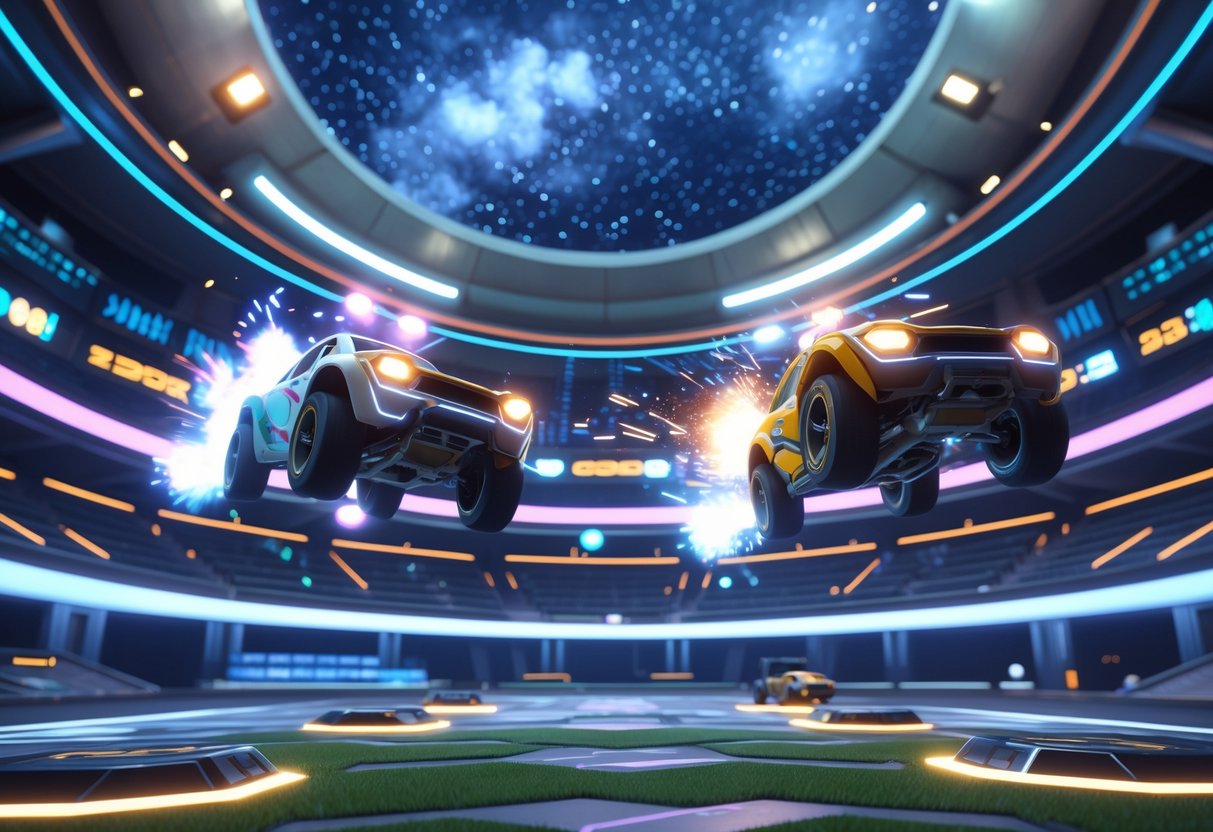
Most players struggle with timing their drops from the ceiling or keeping control of their car during aerial moves. You can get past these problems with targeted training and a few technique tweaks.
How can I master the ceiling shot in Rocket League?
Start by learning the right approach. Drive up the wall at a medium pace and keep control as you move onto the ceiling.
Line up your car so it falls naturally toward where the ball will be. Don’t rush the timing—let gravity help you out.
Practice getting a good pop off the wall first. Try hitting the ball with different parts of your car to see how it changes the ball’s path.
Use freeplay mode to repeat the setup over and over. Focus on being consistent before you go for anything fancy.
What are the best techniques for maintaining control of the car when playing off the ceiling?
Keep your car’s nose slightly down as you drop from the ceiling. That gives you better control of your descent.
Use little boost taps instead of holding boost down. Quick bursts let you adjust without overshooting.
Practice air roll while you’re upside down. Your muscle memory needs to get used to the flipped controls.
Don’t freak out when falling—trust your position and make smooth, small corrections instead of big, jerky ones.
Could you share some training exercises to improve ceiling play in Rocket League?
Try the “Ceiling Shots” training pack in the Featured section. It gives you steady setups to work on timing and accuracy.
Set up your own drill in freeplay. Drive the ball up the wall, follow it to the ceiling, then drop down for a shot.
Practice just falling from the ceiling and touching the ball—don’t worry about shooting at first.
Try the “Uncomfortable Saves” training pack. It forces you to make saves from tricky ceiling spots.
Spend 15-20 minutes a day on ceiling play. Short, regular practice works better than marathon sessions.
What’s the secret to consistently dropping down from the ceiling and striking the ball accurately?
Read the ball’s momentum before you even reach the ceiling. Try to predict where it’ll be, not just where it is.
Time your fall so you and the ball meet at the same spot.
Keep your car lined up with your target as you drop. Small tweaks work better than big swings.
Don’t flip too soon. Wait until you’re close to the ball before you dodge.
Practice the timing in slow motion first. Training packs with consistent setups help a lot.
Are there any specific controller settings that might help with executing ceiling plays more effectively?
Bump your aerial sensitivity up to 1.2-1.4. It gives you finer control on the ceiling.
Try binding air roll left or right to a shoulder button. It makes ceiling moves easier to pull off.
Lower your deadzone settings a bit. You want precise stick movements for ceiling shots.
Mess with your camera settings too. Some players like a higher camera distance for better awareness.
What are some common mistakes players make when attempting to play from the ceiling, and how can I avoid them?
Try not to rush toward the ceiling. If you go up too fast, you’ll probably struggle to control your fall or time your shot.
Hold back on using all your boost right away. You’ll want some left for quick adjustments when you’re coming down.
Let your teammates take the shot if they’re in a better spot. Honestly, game sense usually beats pulling off a flashy move.
Think twice before going for a ceiling shot from an awkward angle. It’s usually smarter to wait for a better setup than to force something difficult.
Pay attention to your car’s orientation. If you lose track of which way is up, things can get confusing fast.

